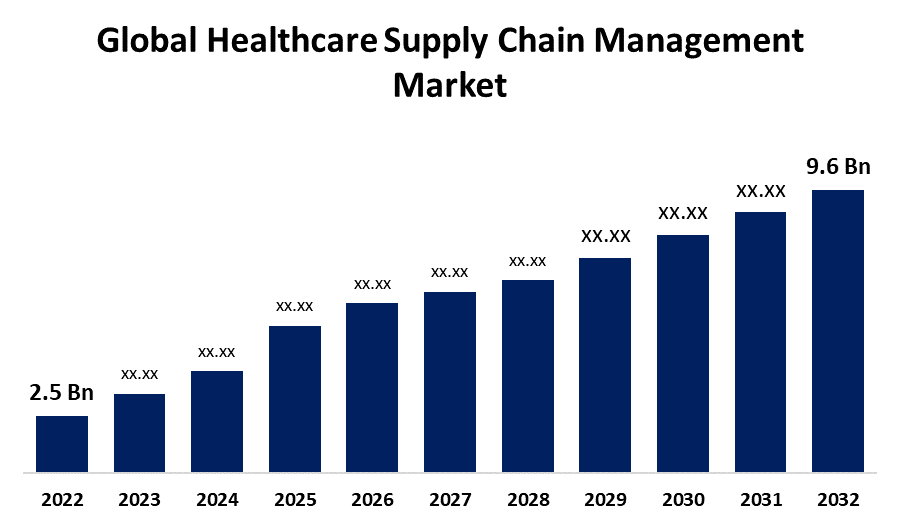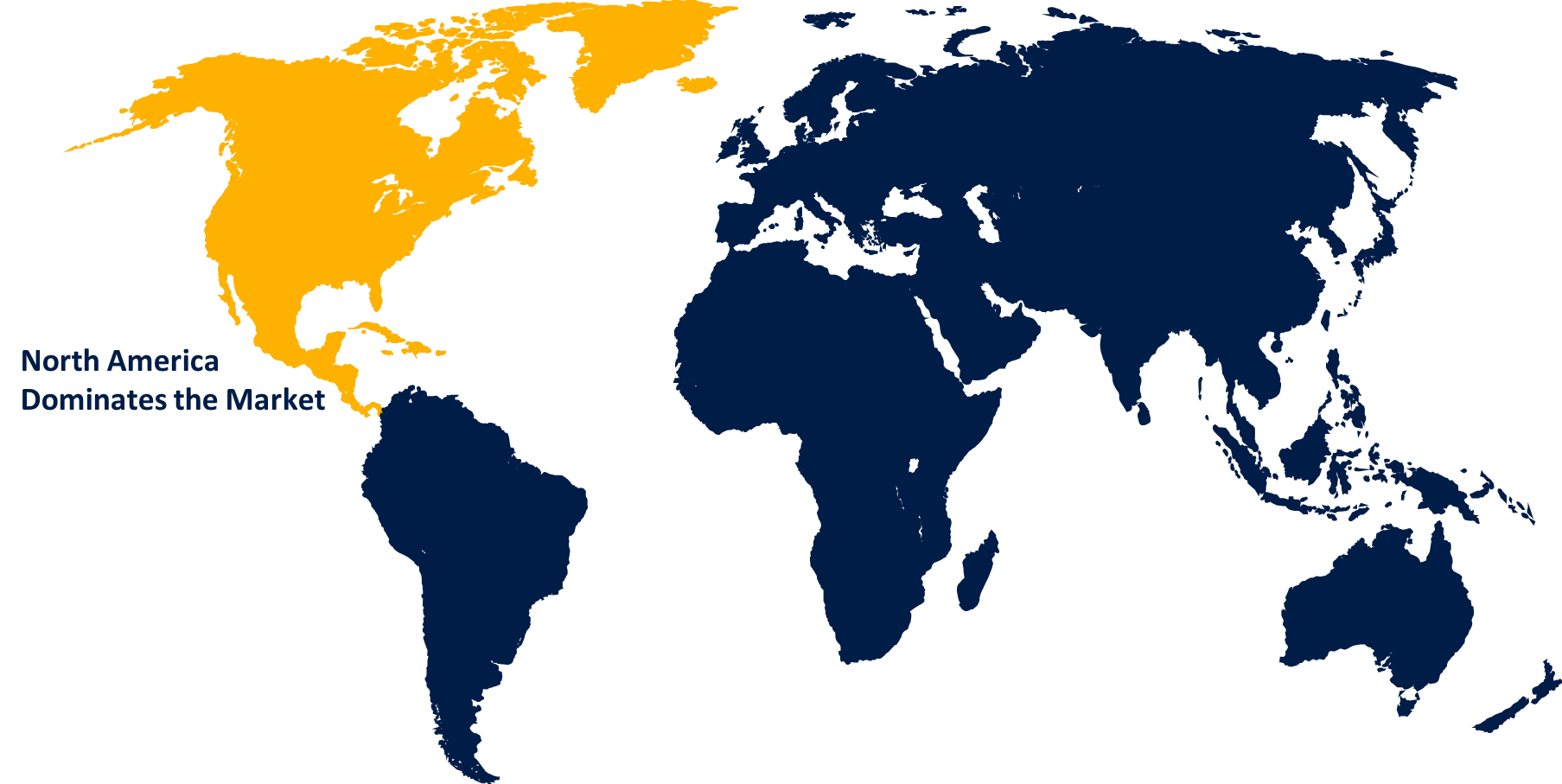Global Healthcare Supply Chain Management Market Size, Share, and COVID-19 Impact Analysis, By Component (Software, Hardware, Services), By Delivery Mode (On-premise, Cloud-based), By End-user (Healthcare Providers, Healthcare Manufacturers, Others), and By Region (North America, Europe, Asia-Pacific, Latin America, Middle East, and Africa), Analysis and Forecast 2022 - 2032
Industry: HealthcareGlobal Healthcare Supply Chain Management Market Insights Forecasts to 2032
- The Global Healthcare Supply Chain Management Market Size was valued at USD 2.5 Billion in 2022.
- The Market Size is growing at a CAGR of 14.4% from 2022 to 2032
- The Worldwide Healthcare Supply Chain Management Market Size is expected to reach USD 9.6 Billion by 2032
- Asia Pacific Market is expected to grow the fastest during the forecast period

Get more details on this report -
The Global Healthcare Supply Chain Management Market Size is expected to reach USD 9.6 billion by 2032, at a CAGR of 14.4% during the forecast period 2022 to 2032.
Healthcare supply chain management plays an essential role in the healthcare industry. It includes many different activities, such as sourcing and procurement, as well as logistics and distribution. The main objective of supply chain management is to ensure that patients receive the care they require when they require it, while also reducing expenses and waste. Healthcare supply chain management is the process of monitoring and managing the flow of healthcare products to eliminate inventory waste, reduce human error, and improve patient care. It includes inventory management, resource acquisition, and product delivery to providers and patients. The adoption of methods to reduce expenses by hospitals and physicians is increasing the demand for effective supply chain management in the healthcare sector. Several organizational efforts to improve the agility and resilience of their supply chain operations have increased demand for the global supply chain management market.
Global Healthcare Supply Chain Management Market Report Coverage
| Report Coverage | Details |
|---|---|
| Base Year: | 2022 |
| Market Size in 2022: | USD 2.5 Billion |
| Forecast Period: | 2022-2032 |
| Forecast Period CAGR 2022-2032 : | 14.4% |
| 2032 Value Projection: | USD 9.6 Billion |
| Historical Data for: | 2019-2021 |
| No. of Pages: | 249 |
| Tables, Charts & Figures: | 120 |
| Segments covered: | By Component, By Delivery Mode, By End-user, By Region |
| Companies covered:: | Oracle, Epicor Software Corporation, McKesson CORPORATION, Ochsner Health, Ascension, Global Healthcare Exchange, LLC., Tecsys Inc., Banner Health, Henry Schein, Inc., Cardinal Health and Other Key Vendors. |
| Pitfalls & Challenges: | COVID-19 Empact,Challenges, Future, Growth, & Analysis |
Get more details on this report -
Driving Factors
The launch of advanced supply chain solutions will propel market growth. Organizations across the globe have had the opportunity to modify their services with the help of innovative technology, solutions, and tools. Globally, supply chain management has grown in popularity as organizations begin to integrate their key business operations from the beginning to the end. Increasing adoption of cloud-based software solutions by healthcare professionals is one of the key factors driving the healthcare supply chain management market. Significant advancements in data security in supply chain management solutions are increasing their adoption. Furthermore, various solutions are being launched to improve transparency and efficiency across all organizational processes. These solutions help clinicians focus more on patient care outcomes by lowering costs, automating procurement, and making supply chain processes more efficient. Hence, by enhancing patient outcomes by streamlining supply chain operations across the healthcare system, these new solutions are positively contributing to the growth of the healthcare supply chain management market during the forecast period.
Restraining Factors
Supply chain management software, whether installed or upgraded, can be costly. The price is usually determined by the number of applications provided by the software. Furthermore, high costs are caused by expensive provider preference items, a lack of health IT implementation for supply chain functions, and a lack of hidden cost transparency. The high cost associated with implementing these solutions limits market growth by limiting the adoption rate. As a result, one of the major concerns among healthcare facilities is cost management.
Market Segmentation
By Component Insights
The software segment is expected to dominate the global healthcare supply chain management market during the forecast period.
Based on the component, the global healthcare supply chain management market is classified into software, hardware, and services. Among these, the software segment is expected to dominate the global healthcare supply chain management market during the forecast period. The growing adoption of software such as software as a service (SaaS) that offers next-generation cloud computing applications such as supply chain management enterprise resource planning are among key factors boosting the healthcare supply chain management market growth. The growing need in healthcare organizations for efficient management of organizational workflows, as well as a shift in the trend toward value-based care in developed economies, are driving segment growth during the forecast period.
By Delivery Mode Insights
The cloud-based segment accounted for a significant market share over the forecast period.
Based on the delivery mode, the healthcare supply chain management market is segmented into on-premise and cloud-based. Among these, the cloud-based segment accounted for a significant market share over the forecast period. The growth can be attributed to the benefits associated with it, such as risk mitigation, monitoring, and identification of supply chain risks, vulnerabilities, and disruptions. Furthermore, the platform allows for the collaborative sharing of information. Furthermore, as cloud-based services are designed as a pay-as-you-go model, it reduces the need for physical infrastructure, leading to a much lower financial investment. As a result, demand for the cloud-based delivery segment has increased significantly and is expected to grow at the fastest rate during the forecast period
By End User Insights
The healthcare manufacturers segment is witnessing substantial CAGR growth over the forecast period.
Based on the end user, the healthcare supply chain management market is segmented into healthcare providers, healthcare manufacturers, and others. Among these, the healthcare manufacturers segment holds the market with substantial CAGR growth over the forecast period. Pharmaceutical companies have benefited significantly from emerging IT trends and technologies such as cloud computing. The growing use of SaaS software by healthcare manufacturers is shifting the trend out of paper-based operations and toward an automated system. This reduced the risk of errors while also overcoming major challenges such as efficient planning and visibility into consigned inventory. Furthermore, the pharmaceutical industry generates petabytes of data every second through a wide range of data streams, including R&D and CRM systems. Hence, cloud computing helps by allowing companies to store important data in a global network that can be accessed from anywhere in the world and from any device.
Regional Insights
North America accounted for the highest market share over the forecast period.

Get more details on this report -
North America accounted for the highest market share over the forecast period. This can be attributed to the mandatory implementation of GS1 standards and unique device identifiers (UDIs) on pharmaceutical drugs and medical devices. The increasing adoption of scanning technologies, such as barcodes and RFID, to combat counterfeit drugs has aided in drug tracking. Manufacturers in the United States have begun to use edible barcodes to combat the counterfeit drug trade. Furthermore, the adoption of these scanning technologies by healthcare providers and distributors is driving North American market growth during the forecast period.
Asia Pacific’s healthcare supply chain management market is expected to grow with a significant share during the forecast period. The growth can be attributed to factors such as constantly developing healthcare IT infrastructure and rising demand for cloud computing. Furthermore, China's healthcare supply chain management market had the largest market share, while India's healthcare supply chain management market was the Asia-Pacific regional fastest growing market.
List of Key Market Players
- Oracle
- Epicor Software Corporation
- McKesson CORPORATION
- Ochsner Health
- Ascension
- Global Healthcare Exchange, LLC.
- Tecsys Inc.
- Banner Health
- Henry Schein, Inc.
- Cardinal Health
Key Market Developments
- In May 2022, Global Healthcare Exchange, LLC. announced a partnership with the Healthcare Industry Resiliency Collaborative (HIRC) to develop a transparent and resilient healthcare supply chain.
- In February 2022, Cardinal Health announced a collaboration with the Kinaxis RapidResponse platform in order to improve medical product visibility and supply chain agility.
- In January 2022, Tecsys Inc. announced the commercialization of its automated inventory management and management insight solutions for clinical labs.
Market Segment
This study forecasts revenue at global, regional, and country levels from 2022 to 2032. Spherical Insights has segmented the global healthcare supply chain management market based on the below-mentioned segments:
Global Healthcare Supply Chain Management Market, Product Analysis
- Software
- Hardware
- Services
Global Healthcare Supply Chain Management Market, Delivery Mode Analysis
- On-premise
- Cloud-based
Global Healthcare Supply Chain Management Market, End User Analysis
- Healthcare Providers
- Healthcare Manufacturers
- Others
Global Healthcare Supply Chain Management Market, Regional Analysis
- North America
- US
- Canada
- Mexico
- Europe
- Germany
- Uk
- France
- Italy
- Spain
- Russia
- Rest of Europe
- Asia Pacific
- China
- Japan
- India
- South Korea
- Australia
- Rest of Asia Pacific
- South America
- Brazil
- Argentina
- Rest of South America
- Middle East & Africa
- UAE
- Saudi Arabia
- Qatar
- South Africa
- Rest of the Middle East & Africa
Need help to buy this report?